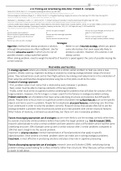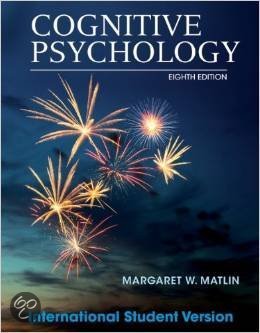2.1C Thinking and remembering 2021/2022- Problem 8 – Compute
A How do we apply strategies? How do we acquire #insight and how do we
How do people solve problems? B apply it in novel situations?
What is required in good problem solving? How do we solve seemingly impossible C
What is a good way to solve this kind of problems? What is creative problem solving?
problem? How do we think outside the box? How do you apply creative problem solving?
How do you come up with a strategy?
Strategies:
Algorithm: method that always produces a solution, Better to use a heuristic strategy; where you ignore
although the processes are often inefficient. Like for some alternatives that seem especially likely to
instance exhaustive search: in which you try out all produce a solution. However, this solution is not
possible answers using a specified system. always correct.
When solving problem: need to weigh the benefits of heuristic’s speed against the costs of possible missing the
correct solution.
Most widely used heuristics:
1. Analogy approach: where you employ a solution to a similar, earlier problem to help you solve a new
problem. Widely used e.g. engineers building an airplane by creating analogy between wings of bird and
plane. They noticed birds could control their flight patterns by making small adjustments in the orientation of
their wing tips and therefore designed airplane wing tips so that pilots could do the same.
Structure of analogy approach:
- First, problem solver must notice that a relationship exists between 2 problems.
- Next, solver must be able to map key elements of the two problems.
- Finally, solver must arrive at a general schema underlying the problems that will allow for solution of the
target problem. However, the first stage is a major culprit for the failures in analogical problem solving.
Problem isomorphs: set of problems that have same underlying structures and solutions but diff specific
details. People tend to focus more on superficial content of problem like surface features such as the specific
objects and terms used in a problem. People fail to emphasize structural features: underlying core that they
must understand in order to solve the problem correctly. Research shows that people often fail to see the
analogy between a problem they’ve previously solved and a new problem with similar structural features.
Why? Failure of memory, a retrieval cue would help, but there isn’t one in everyday problems.
Factors encouraging appropriate use of analogies: pp are more likely to use the strategy correctly when they
try several structurally similar problems before they tackle the target problem e.g. Gick & Holyoak (1983);
research asked people to solve a certain problem and later asked to solve a diff problem which had the same
underlying structure: 30% of people came up with a similar solution after 2 similar problems compared to
10% that went straight into the second problem.
Important is schema induction: mental representation of facts/procedures that apply to specific
object/situation. Once schema is formed: problem solver can make use in solving analogous problems.
Enactment: is most effective in producing solutions and plays a key role in cognitive processing.
Factors discouraging appropriate use of analogies: research Lane and Schooler (2004): verbalizing during
problem solving caused looking for surface similarity rather than structural. Why? Because surface similarity
is easier to talk about.
, 2. Means-ends heuristic: most effective and flexible: requires you to identify the wanted ‘end’/final result and
then figure out the ‘means’/methods to reach the end. Important components
1. Divide the problem into a number of 2. Try to reduce the diff between the initial state
subproblems/smaller problems and and goal state for each of the subproblems.
Research on the mean-ends heuristic: pp solve problems by using means-ends analysis on a daily basis.
Sometimes correct solution requires to move backward, temporarily increasing the difference between the
initial state and the goal state. Pp are reluctant to do so, even if the correct solution requires them to do so.
3. Hill-climbing heuristic: most straightforward: imagine hiking along a path in an unfamiliar area with goal to
reach top of a hill. Ahead, there’s a fork in the path: unfortunately, you cannot see far into the distance on
either of the two paths, because your goals is to climb upward, you select steepest path. Similarly, if using
this heuristic: you consistently choose the alternative that seems to lead most directly toward your goal. Can
be useful when you do not have enough alternative info, because you can only see the immediate next step.
Biggest drawback: you might miss indirect alternatives with greater long-term benefits, also, this heuristic
does not guarantee that you’ll end up on the top of the hill. Major point: this heuristic encourages short-term
goals, rather than long-term solutions e.g. students with high salary as goal may take a job immediately after
college, although a graduate degree would yield greater long-term benefits (sometimes best solution
requires us to move backward).
- Best mode of processing for solving problems would depend on one’s level of knowledge and experience.
- Many problems cannot be solved with above standard approaches, because problems are too complex.
Study in USA, Philippines, Germany, Brazil, India: had to think aloud during 90 min problem solving session:
Micro worlds: tasks that require the problem solver to make series of connected decisions as they try to
solve a complex problem that could occur IRL e.g. assuming the role of a commanding officer in a fire
brigade to extinguish forest fires.
Hypothesis: cultures with economic resources (Germany, USA) would be more likely to emphasize
planning, compared to countries with limited resources (the rest).
Results: Germans emphasized planning the most, USA – Brazil and India made intermediate number of
planning and Filipinos made smallest number of planning comments. How? USA tend to focus on
immediate gratification, rather than long-range planning.
Two string problem= subjects are shown two strings hanging from the ceiling and are instructed to tie the
strings together. The strings are placed apart so that subjects are unable to grasp both strings simultaneously.
The solution involves the use of items which are available in the vicinity of the strings= example of an ill-
structured problem: there are no clear, readily available paths to solution.
Both domain knowledge and justification skills are important for solving both ill- and well-structured problems.
Justifications skills: because ill structured problems can be represented in diff ways and often have alternative
solutions. Thus, problem solvers need to choose and justify their selection of a particular representation and
solution.
Insight problems: you need to see the problem in a novel way/differently from how you would probably see
the problem at first, and differently from how you would probably solve problems in general: you must
restructure your representation of the problem to solve it. Insight may feel as though they’re sudden, but are
often the result of much prior thought and hard work without which the insight would’ve never occurred
Early Gestaltist view: emphasized importance of the whole as more than a collection of parts. Insight
problems require problem solvers to perceive the problem as a whole.
Max Wertheimer (1945/1959): productive thinking: involves insights that go beyond bounds of existing
associations ↔ diff from reproductive thinking (based on existing associations involving what is already
known). Insight is a special process involving thinking that differs from normal, linear info processing.






